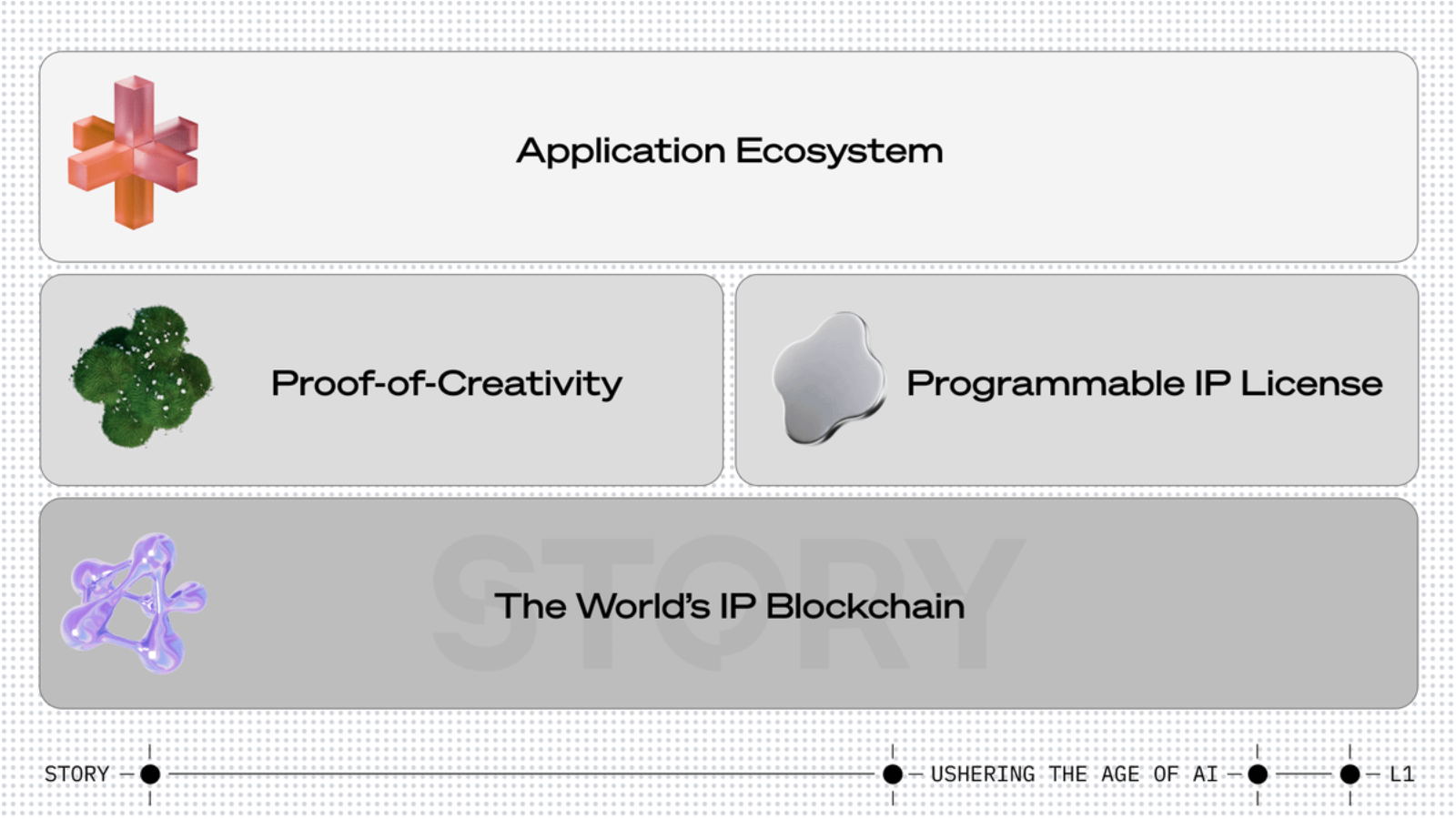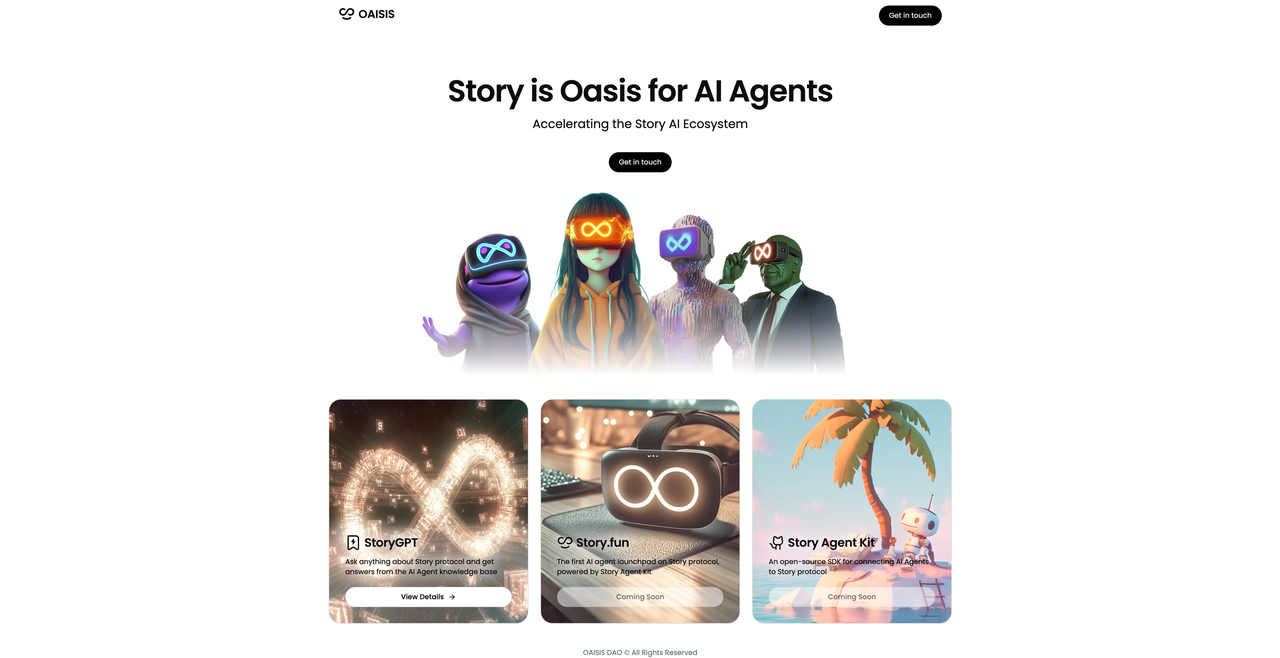In traditional intellectual property management, content creators often rely on conventional platforms for showcasing their works. However, these platforms frequently profit from opaque revenue distribution mechanisms, making it difficult for creators to obtain fair value from their content creation.
Creators face multiple challenges: First, rights protection is difficult; creators often struggle to prove the source of their rights, and off-chain processes are cumbersome and lack transparency. Second, revenue distribution is unfair; a significant amount of revenue from IP derivatives cannot accurately flow back to the original creators. Finally, the authorization process is complex, with manual negotiations and paperwork consuming a lot of time and energy.
To address these issues, Story Protocol offers a decentralized way to change the interaction between content creators and consumers, utilizing blockchain technology to ensure ownership, transparency, and fair distribution of content, allowing creators to focus on their creativity.
1. What is Story Protocol?
Story Protocol - Introducing a Global Intellectual Property Blockchain
Story is a dedicated Layer 1 blockchain designed specifically for intellectual property. It can tokenize any type of IP, whether it be creative works, images, real-world assets, songs, AI models, NFTs, portrait rights, or anything in between. By embedding terms of use, ownership, and royalty agreements directly into the blockchain, Story provides a transparent and decentralized solution for IP management. This enables IP holders to protect their works, collaborate seamlessly, and unlock more revenue opportunities in an AI-driven economy.
Project Background
Story Protocol was founded by Jason Zhao, Seung Yoon Lee, and Jason Levy, with a team of experts in crypto, intellectual property, and AI technology. Additionally, since 2023, it has completed three rounds of large-scale financing, with a16z participating in all three rounds, raising the total funding to $134 million.
2. Story Technology Architecture and Implementation
The Story Protocol consists of multiple elements: the Story Network (L1), the Creativity Proof Protocol (smart contracts), and Programmable IP Licenses.

Story Network
The Story Network is a purpose-built Layer 1 blockchain that achieves the best features of EVM and Cosmos SDK. It is fully compatible with EVM and has undergone deep execution layer optimization to support graph data structures, designed specifically for quickly and cost-effectively processing complex data structures (such as IP). Specific implementation methods include:
- Using precompiled primitives: Traversing complex data structures like IP graphs in seconds at marginal cost.
- A consensus layer based on the mature CometBFT stack: Ensuring fast determinism and low-cost transactions.
Creativity Protocol
The "Creativity Proof" protocol of Story introduces a revolutionary open programmable IP layer, elevating IP to a first-class entity within the blockchain ecosystem. At the core of this system is the IP asset and its associated IP account, which is a smart contract designed to serve as the core identity for each IP. This account-centric approach can store and manage data related to IP, as well as operate on this data through various functions executed by modules.
Modules are customizable smart contracts used to define and extend the functionality of IP accounts. They enable developers to create functionalities and interactions for each IP, making IP truly programmable.
IP asset owners can set terms for their IP, and then creators of derivative works can seamlessly expand their works by minting "license tokens" (as outlined in the terms and represented as NFTs themselves), creating revenue streams from derivative works through the royalty module, or raising disputes through the dispute module.
Programmable IP Licenses (PIL)
PIL is a real off-chain legal contract that defines certain licensing terms, stipulating how to legally license IP assets. For example, how to commercialize or remix IP assets, who is allowed to do so, and under what conditions.
Although it is on-chain, the terms of the IP asset and the minted license tokens are enforced by an off-chain legal contract known as Programmable IP Licenses (PIL). This contract allows anyone to transfer tokenized IP into the off-chain legal system. More specifically, the aforementioned IP assets and modules are means to automate and enforce these terms on-chain, establishing a mapping between the legal world (PIL) and the blockchain, similar to how USDC supports fiat currency exchanges, PIL similarly supports IP exchanges.
3. Latest Project Progress of Story Protocol
Technical Development Progress:
Architecture Design Completed: The foundational technical architecture of Story Protocol has been completed, and the core team is conducting in-depth testing and optimization to ensure the platform's stability and security.
Smart Contract Development: Smart contracts for intellectual property management are being developed, which will be responsible for handling key functions such as content creation, royalty distribution, and copyright management.
Testnet Launched:
Test Network: Story Protocol recently launched a test network (Testnet) for developers and community members to test the protocol's functionalities. This phase will allow users to provide feedback to refine various modules of the system, ensuring the platform reaches optimal status before its official launch.
Next Steps:
The mainnet of Story Protocol is expected to go live, along with the launch of a beta content creation platform to encourage active participation from creators.
Latest Updates:

Story Protocol plans to launch TCP/IP for AI agents, aiming to build a trading market between AI agents. As countless on-chain AI agents will emerge in the future, there will be a need for interaction and trading among these AI agents. Story plans to integrate frameworks like a16z's Eliza and Virtual's GAME, with the goal of enabling all agents to trade IP assets with each other in the future.
4. Challenges Faced by Story Protocol
In promoting the transformation of intellectual property management and content creation, Story Protocol faces a series of significant challenges that could not only constrain its development speed but also impact the overall success of the project. The following are the main challenges analyzed from several key perspectives:
1) Difficulty in Integrating Existing IP
As the shift towards decentralization occurs, integrating existing intellectual property (IP) will be a daunting task. Especially on Web2 platforms, creators often need to sign agreements that transfer some rights to the platform upon registration. This practice contradicts Story Protocol's goal of ensuring creators have complete control over their content and revenue distribution. Therefore, gaining the trust of existing creators and encouraging them to migrate to the new platform is a challenge that Story Protocol must face. If creators are accustomed to the conveniences and protections offered by existing platforms, they may be cautious about transitioning to a new decentralized platform.
2) Interaction Between the Ecosystem and Real-World Laws
To realize the full potential of Story Protocol, the mechanisms within the ecosystem must consider how to effectively interact with real-world legal systems. While Story Protocol provides a transparent and decentralized solution for IP management through smart contracts and blockchain technology, this does not mean it can completely replace traditional legal frameworks. In cases of intellectual property disputes or violations, ensuring that these legal terms are enforced on-chain and connect with real-world laws will be a significant challenge.
3) Mechanism Design Challenges from the Creator's Perspective
From the creator's perspective, another challenge Story Protocol faces is its mechanism design, particularly the reward mechanism. In Web2 platforms, content homogenization is severe, and this issue may also reappear in Story Protocol. If the content among creators on the platform lacks differentiation, user engagement will decrease, ultimately affecting the quality of content and the fairness of rewards. Therefore, Story Protocol needs to design differentiated incentive mechanisms to encourage diverse creation and promote innovation and unique content production.
Conclusion
Story Protocol is committed to providing content creators with a safer and more transparent intellectual property management and revenue mechanism by introducing a global intellectual property blockchain. The construction of a public chain, the introduction of programmable IP licenses, and decentralized content governance all provide unprecedented protection and opportunities for content creators and users. Although challenges remain, with the growing demand for decentralized content platforms, Story Protocol is expected to play an important role in the future market. By adhering to technological innovation, market sensitivity, and legal compliance, Story Protocol will promote the sustainable development of the digital content economy and redefine the management of intellectual property and the way content is created.
免责声明:本文章仅代表作者个人观点,不代表本平台的立场和观点。本文章仅供信息分享,不构成对任何人的任何投资建议。用户与作者之间的任何争议,与本平台无关。如网页中刊载的文章或图片涉及侵权,请提供相关的权利证明和身份证明发送邮件到support@aicoin.com,本平台相关工作人员将会进行核查。




